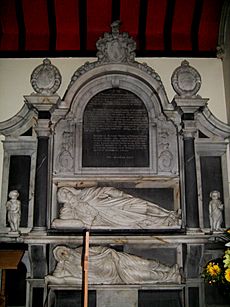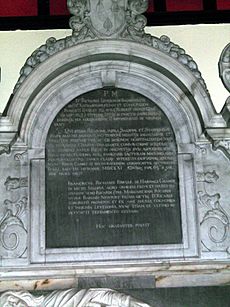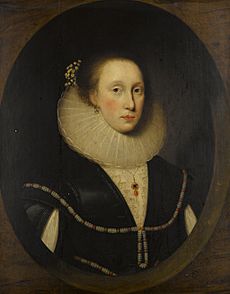Richard Leveson (1598–1661) facts for kids
Sir Richard Leveson (born May 25, 1598 – died June 2, 1661) was an important English politician. He was a member of the House of Commons, which is like a parliament, from 1640 to 1642. During the English Civil War, he supported the King, also known as the Royalist side.
Contents
Sir Richard Leveson: A Life in English History
Sir Richard Leveson was born in 1598. He was the second son of Sir John Leveson. His family lived in Halling, Kent. In 1605, he inherited land and property. This inheritance came from his father's cousin, also named Sir Richard Leveson. These properties were in Trentham, Staffordshire and Lilleshall, Shropshire.
Early Life and Family Connections
Richard's older brother, John, was supposed to inherit their father's main estates. However, John passed away in 1612. This happened three years before their father died. Because of this, Richard inherited not only the properties from his cousin but also his father's estates in Kent.
He decided to rebuild his family home. This home was Trentham Hall. The work on Trentham Hall took place between 1630 and 1638. It was a very big project. His relatives in Staffordshire were also important. For example, Colonel Thomas Leveson supported King Charles I. He held Dudley Castle for the King during the Civil War.
A Politician During Tumultuous Times
In 1626, Richard Leveson was made a Knight of the Bath. This was a special honor. It happened at the coronation of King Charles I.
In November 1640, Leveson was chosen to be a Member of Parliament. He represented Newcastle-under-Lyme. This was part of the Long Parliament. He worked to gain support for the King in Staffordshire.
The English Civil War and Its Impact
The English Civil War was a difficult time. Because Sir Richard raised forces to support the King, he was removed from Parliament. This happened on November 24, 1642. From 1643 to 1645, he served in the King's army. He was a colonel in the cavalry.
In 1645, the Parliament's army took over Lilleshall Abbey. Sir Richard Leveson was then captured. He was held prisoner by the Parliament's forces. They also took most of the money from his coal and lime businesses. He had to pay a large fine too.
Later Life and Legacy
After the King was restored to power, Sir Richard continued to serve. He was a captain of volunteer horsemen in Staffordshire. He passed away in Lilleshall in 1661. He was 63 years old. He was buried at St Michael's Church in Lilleshall.
Sir Richard Leveson married Katherine Dudley. They did not have any children. Lady Katherine passed away in 1674.
Lady Katherine's Lasting Impact
In her will, Lady Katherine left money for important causes. She helped set up almshouses. These were homes for people who needed help. She also created a fund for education. These charities still exist today. The Lady Katherine Leveson Foundation helps people. The Lady Katherine Leveson C of E Primary School continues her work in education.
Portraits of Sir Richard
Sir Richard Leveson's elder brother, John, had two daughters. They became co-heiresses. One of them, Christian, married Sir Peter Temple. A portrait of Sir Richard Leveson was found in the art collection at Stowe House. This house is in Buckingham.
Another portrait of Sir Richard Leveson was owned by the Duke of Sutherland. This painting was thought to be by the famous artist Anthony van Dyck. It was bought in 1848 at an auction. The painting showed Sir Richard in a black dress with a frill. It was a very popular painting at the sale.




